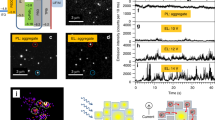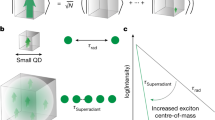Abstract
In the search for novel, robust quantum emitters, inorganic lead halide perovskite nanocrystals have emerged as potential colloidal sources of coherent single photons. While colloidal perovskite nanocrystals offer a great source of synthetically scalable, tunable photon sources, observation of two-photon quantum interference from the emission of any colloidal nanoparticle has not been previously reported. In this work we prepare large CsPbBr3 nanocrystals and observe direct evidence of interference between indistinguishable single photons sequentially emitted from a single nanocrystal. We measure Hong–Ou–Mandel interference from photons in CsPbBr3 nanocrystals, showing corrected visibilities of up to 0.56 ± 0.12 in the absence of any radiative enhancement or photonic architecture. These results demonstrate the unique potential of perovskite nanocrystals to serve as scalable, colloidal sources of indistinguishable single photons.
This is a preview of subscription content, access via your institution
Access options
Access Nature and 54 other Nature Portfolio journals
Get Nature+, our best-value online-access subscription
$29.99 / 30 days
cancel any time
Subscribe to this journal
Receive 12 print issues and online access
$209.00 per year
only $17.42 per issue
Buy this article
- Purchase on Springer Link
- Instant access to full article PDF
Prices may be subject to local taxes which are calculated during checkout




Similar content being viewed by others
Data availability
All the datasets that support the findings of this study are available on Figshare or from the corresponding author on reasonable request. Source Data are provided with this paper.
References
Knill, E., Laflamme, R. & Milburn, G. J. A scheme for efficient quantum computation with linear optics. Nature 409, 46–52 (2001).
Tanzilli, S. et al. A photonic quantum information interface. Nature 437, 116–120 (2005).
O’Brien, J. L., Pryde, G. J., White, A. G., Ralph, T. C. & Branning, D. Demonstration of an all-optical quantum controlled-NOT gate. Nature 426, 264–267 (2003).
O’Brien, J. L., Furusawa, A. & Vučković, J. Photonic quantum technologies. Nat. Photon. 3, 687–695 (2009).
Gisin, N., Goire Ribordy, G., Tittel, W. & Zbinden, H. Quantum cryptography. Rev. Mod. Phys. 74, 145 (2002).
Zhang, L., Silberhorn, C. & Walmsley, I. A. Secure quantum key distribution using continuous variables of single photons. Phys. Rev. Lett. 100, 110504 (2008).
Hong, C. K., Ou, Z. Y. & Mandel, L. Measurement of subpicosecond time intervals between two photons by interference. Phys. Rev. Lett. 59, 2044 (1987).
Close, T., Gauger, E. M. & Lovett, B. W. Overcoming phonon-induced dephasing for indistinguishable photon sources. New J. Phys. 14, 113004 (2012).
Reigue, A. et al. Probing electron–phonon interaction through two-photon interference in resonantly driven semiconductor quantum dots. Phys. Rev. Lett. 118, 233602 (2017).
Thoma, A. et al. Exploring dephasing of a solid-state quantum emitter via time- and temperature-dependent Hong–Ou–Mandel experiments. Phys. Rev. Lett. 116, 1–5 (2016).
He, Y. M. et al. On-demand semiconductor single-photon source with near-unity indistinguishability. Nat. Nanotechnol. 8, 213–217 (2013).
Somaschi, N. et al. Near-optimal single-photon sources in the solid state. Nat. Photon. 10, 340–345 (2016).
Wang, H. et al. On-demand semiconductor source of entangled photons which simultaneously has high fidelity, efficiency, and indistinguishability. Phys. Rev. Lett. 122, 113602 (2019).
Tomm, N. et al. A bright and fast source of coherent single photons. Nat. Nanotechnol. 16, 399–403 (2021).
Santori, C. et al. Nanophotonics for quantum optics using nitrogen-vacancy centers in diamond. Nanotechnology 21, 274008 (2010).
Sipahigil, A. et al. Indistinguishable photons from separated silicon-vacancy centers in diamond. Phys. Rev. Lett. 113, 113602 (2014).
Evans, R. E. et al. Photon-mediated interactions between quantum emitters in a diamond nanocavity. Science 362, 662–665 (2018).
Luo, Y. et al. Carbon nanotube color centers in plasmonic nanocavities: a path to photon indistinguishability at telecom bands. Nano Lett. 19, 9037–9044 (2019).
Grosso, G. et al. Tunable and high-purity room temperature single-photon emission from atomic defects in hexagonal boron nitride. Nat. Commun. 8, 705 (2017).
Spokoyny, B. et al. Effect of spectral diffusion on the coherence properties of a single quantum emitter in hexagonal boron nitride. J. Phys. Chem. Lett. 11, 1330–1335 (2020).
de Mello Donegá, C., Bode, M. & Meijerink, A. Size- and temperature-dependence of exciton lifetimes in CdSe quantum dots. Phys. Rev. B 74, 085320 (2006).
Utzat, H. et al. Coherent single-photon emission from colloidal lead halide perovskite quantum dots. Science 363, 1068–1072 (2019).
Beyler, A. P., Marshall, L. F., Cui, J., Brokmann, X. & Bawendi, M. G. Direct observation of rapid discrete spectral dynamics in single colloidal CdSe-CdS core-shell quantum dots. Phys. Rev. Lett. 111, 177401 (2013).
Protesescu, L. et al. Nanocrystals of cesium lead halide perovskites (CsPbX3, X = Cl, Br, and I): novel optoelectronic materials showing bright emission with wide color gamut. Nano Lett. 15, 3692–3696 (2015).
Kovalenko, M. V., Protesescu, L. & Bodnarchuk, M. I. Properties and potential optoelectronic applications of lead halide perovskite nanocrystals. Science 358, 745–750 (2017).
Zhang, F. et al. Brightly luminescent and color-tunable colloidal CH3NH3PbX3 (X = Br, I, Cl) quantum dots: potential alternatives for display technology. ACS Nano 9, 4533–4542 (2015).
Tong, Y. et al. From precursor powders to CsPbX3 perovskite nanowires: one-pot synthesis, growth mechanism, and oriented self-assembly. Angew. Chem. Int. Ed. 56, 13887–13892 (2017).
Krieg, F. et al. Colloidal CsPbX3 (X = Cl, Br, I) nanocrystals 2.0: Zwitterionic capping ligands for improved durability and stability. ACS Energy Lett. 3, 641–646 (2018).
Becker, M. A. et al. Bright triplet excitons in caesium lead halide perovskites. Nature 553, 189–193 (2018).
Utzat, H. et al. Probing linewidths and biexciton quantum yields of single cesium lead halide nanocrystals in solution. Nano Lett. 17, 6838–6846 (2017).
Sercel, P. C. et al. Exciton fine structure in perovskite nanocrystals. Nano Lett. 19, 4068–4077 (2019).
Empedocles, S. A. & Bawendi, M. G. Influence of spectral diffusion on the line shapes of single CdSe nanocrystallite quantum dots. J. Phys. Chem. B 103, 1826–1830 (1999).
Santori, C., Fattal, D., Vučković, J., Solomon, G. S. & Yamamoto, Y. Indistinguishable photons from a single-photon device. Nature 419, 594–597 (2002).
Schöll, E. et al. Resonance fluorescence of GaAs quantum dots with near-unity photon indistinguishability. Nano Lett. 19, 2404–2410 (2019).
Madsen, K. H. et al. Efficient out-coupling of high-purity single photons from a coherent quantum dot in a photonic-crystal cavity. Phys. Rev. B 90, 155303 (2014).
Yan, J. et al. Double-pulse generation of indistinguishable single photons with optically controlled polarization. Nano Lett. 22, 1483–1490 (2022).
Dusanowski, Ł. et al. Purcell-enhanced and indistinguishable single-photon generation from quantum dots coupled to on-chip integrated ring resonators. Nano Lett. 20, 6357–6363 (2020).
Bylander, J., Robert-Philip, I. & Abram, I. Interference and correlation of two independent photons. European Phys. J. D 22, 295–301 (2003).
Huber, T., Predojević, A., Föger, D., Solomon, G. & Weihs, G. Optimal excitation conditions for indistinguishable photons from quantum dots. New J. Phys. 17, 123025 (2015).
Reindl, M. et al. Phonon-assisted two-photon interference from remote quantum emitters. Nano Lett. 17, 4090–4095 (2017).
Hudson, A. J. et al. Coherence of an entangled exciton-photon state. Phys. Rev. Lett. 99, 266802 (2007).
Muller, A., Fang, W., Lawall, J. & Solomon, G. S. Creating polarization-entangled photon pairs from a semiconductor quantum dot using the optical stark effect. Phys. Rev. Lett. 103, 217402 (2009).
Acknowledgements
A.E.K.K, C.J.K., W.S., T.S. and D.B.B. acknowledge support from the US Department of Energy, Office of Basic Energy Sciences, Division of Materials Sciences and Engineering under award no. DE-SC00216. H.U. acknowledges support from the US Department of Energy, Office of Basic Energy Sciences, Division of Materials Sciences and Engineering (under award no. DE-FG02-07ER46454). T.S. also acknowledges support from Graduate Fellowship from the Natural Sciences and Engineering Research Council of Canada (NSERC). A.H.P. acknowledges support from a post-doctoral fellowship from the Natural Sciences and Engineering Research Council of Canada (NSERC). C.J.K. thanks A. Penn at MIT.nano for assistance with HAADF-STEM measurements, which were performed in part through the use of MIT.nano’s facilities.
Author information
Authors and Affiliations
Contributions
A.E.K.K. and H.U. conceived of the study. A.E.K.K. designed the experiment, performed sample preparation, acquired all of the single-nanocrystal data and performed all of the data analysis. C.J.K. synthesized the CsPbBr3 perovskite nanocrystals and acquired all of the ensemble data. A.H.P. aided the background research and data interpretation. W.S. assisted in designing the optical set-up and in developing sample preparation procedures. T.S. and D.B.B. helped develop sample preparation procedures. A.E.K.K. wrote the manuscript and all of the authors provided feedback and comments. M.G.B. directed and supervised the research.
Corresponding author
Ethics declarations
Competing interests
The authors declare no competing interests.
Peer review
Peer review information
Nature Photonics thanks the anonymous reviewers for their contribution to the peer review of this work.
Additional information
Publisher’s note Springer Nature remains neutral with regard to jurisdictional claims in published maps and institutional affiliations.
Supplementary information
Supplementary information
Supplementary Discussion and Figs. 1–8.
Source data
Source Data Fig. 1
Statistical Source Data.
Source Data Fig. 2
Statistical Source Data.
Source Data Fig. 3
Statistical Source Data.
Source Data Fig. 4
Statistical Source Data.
Source Data Extended Data Fig. 1
Statistical Source Data.
Source Data Extended Data Fig. 2
Statistical Source Data.
Source Data Extended Data Fig. 3
Statistical Source Data.
Source Data Extended Data Fig. 4
Statistical Source Data.
Source Data Extended Data Fig. 5
Statistical Source Data.
Source Data Extended Data Fig. 6
Statistical Source Data.
Source Data Extended Data Fig. 7
Statistical Source Data.
Source Data Extended Data Fig. 8
Statistical Source Data.
Rights and permissions
Springer Nature or its licensor (e.g. a society or other partner) holds exclusive rights to this article under a publishing agreement with the author(s) or other rightsholder(s); author self-archiving of the accepted manuscript version of this article is solely governed by the terms of such publishing agreement and applicable law.
About this article
Cite this article
Kaplan, A.E.K., Krajewska, C.J., Proppe, A.H. et al. Hong–Ou–Mandel interference in colloidal CsPbBr3 perovskite nanocrystals. Nat. Photon. 17, 775–780 (2023). https://doi.org/10.1038/s41566-023-01225-w
Received:
Accepted:
Published:
Issue Date:
DOI: https://doi.org/10.1038/s41566-023-01225-w
This article is cited by
-
Engineering colloidal semiconductor nanocrystals for quantum information processing
Nature Nanotechnology (2024)
-
Single-photon superradiance in individual caesium lead halide quantum dots
Nature (2024)
-
Designer phospholipid capping ligands for soft metal halide nanocrystals
Nature (2024)
-
Highly stable and pure single-photon emission with 250 ps optical coherence times in InP colloidal quantum dots
Nature Nanotechnology (2023)



